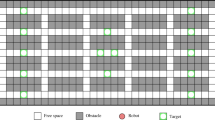Abstract
This paper presents an approach for decentralized real-time motion planning for multiple mobile robots operating in a common 2-dimensional environment with unknown stationary obstacles. In our model, a robot can see (sense) the surrounding objects. It knows its current and its target's position, is able to distinguish a robot from an obstacle, and can assess the instantaneous motion of another robot. Other than this, a robot has no knowledge about the scene or of the paths and objectives of other robots. There is no mutual communication among the robots; no constraints are imposed on the paths or shapes of robots and obstacles. Each robot plans its path toward its target dynamically, based on its current position and the sensory feedback; only the translation component is considered for the planning purposes. With this model, it is clear that no provable motion planning strategy can be designed (a simple example with a dead-lock is discussed); this naturally points to heuristic algorithms. The suggested strategy is based on maze-searching techniques. Computer simulation results are provided that demonstrate good performance and a remarkable robustness of the algorithm (meaning by this a virtual impossibility to create a dead-lock in a “random” scene).
Similar content being viewed by others
Explore related subjects
Discover the latest articles and news from researchers in related subjects, suggested using machine learning.References
Abelson, H. and diSessa, A. 1981. Turtle Geometry. MIT Press: Cambridge, MA.
Buckley, S. 1989. Fast motion planning for multiple moving robots. Proceedings of the IEEE International Conference on Robotics and Automation, pp. 322–326.
Cheung, E. and Lumelsky, V.J. 1989. Proximity sensing in robot manipulator motion planning: System and implementation issues. IEEE Journal of Robotics and Automation, 5(6):740–751.
Erdmann, M. and Lozano-Perez, T. 1987. On multiple moving objects. Algorithmica, 2:477–522.
Harding, E. and Kendall, D. (Eds.), Stochastic Geometry, John Wiley and Sons: London-New York, 1974.
Hopcroft, J., Schwartz, J., and Sharir, M. 1984. On the complexity of motion planning for multiple independent objects: PSPACE hardness of the ‘warehouseman's problem’,. International Journal of Robotics Research 3, 3(4):76–88.
Kant, K. and Zucker, S. 1986. Towards efficient planning: The path-velocity decomposition. International Journal of Robotics Research, 5:72–89.
Lumelsky, V. and Stepanov, A. 1987. Path planning strategies for a point mobile automaton moving amongst unknown obstacles of arbitrary shape. Algorithmica, 3(4):403–430.
Mahadevan, S. and Connell, J. 1992. Automatic programming of behavior-based robots using reinforcement learning. Artificial Intelligence, 55 (2,3):311–365.
Mataric, M. 1994. Interaction and intelligent behavior. Ph.D. Thesis, MIT, Dept. of Electrical Engineering and Computer Science, AITR-1495.
Preparata, F. and Shamos, M. 1985. Computational Geometry, Springer-Verlag: New York.
Scheinman, V. 1987. Robotworld: A multiple robot vision guided assembly system. Proceedings of the International Symposium on Robotics Research.
Schwartz, J. and Sharir, M. 1983. On the piano movers problem—III. Coordinating the motion of several independent bodies. International Journal of Robotics Research, 3.
Spirakis, P. and Yap, C. 1984. Strong NP-hardness of moving many discs. Information Processing Letters, 19:55–59.
Tournassoud, P. 1986. A strategy for obstacle avoidance and its application to multi-robot systems. Proceedings of the IEEE International Conference on Robotics and Automation, pp. 1224–1229.
Yap, C. 1984. Coordinating the motion of several discs. TR-105, Courant Institute of Mathematical Sciences, New York University, New York.
Yegorov, V. 1996. Statistical analysis of sensor-based motion planning algorithms. MS Thesis, Dept. of Computer Science, University of Wisconsin-Madison.
Author information
Authors and Affiliations
Rights and permissions
About this article
Cite this article
Lumelsky, V., Harinarayan, K. Decentralized Motion Planning for Multiple Mobile Robots: The Cocktail Party Model. Autonomous Robots 4, 121–135 (1997). https://doi.org/10.1023/A:1008815304810
Issue Date:
DOI: https://doi.org/10.1023/A:1008815304810




